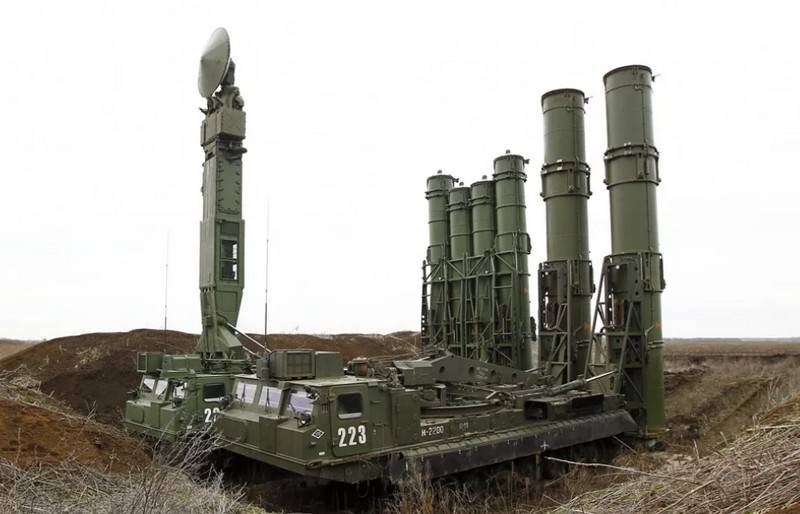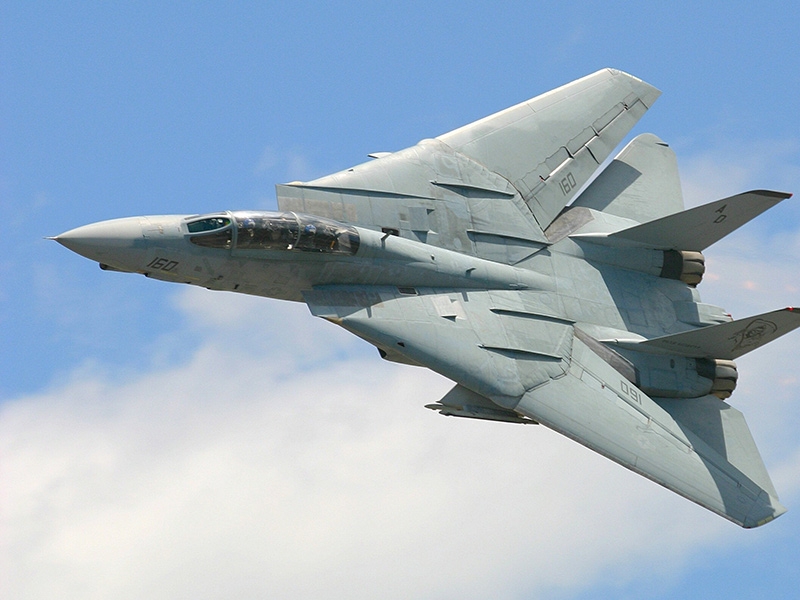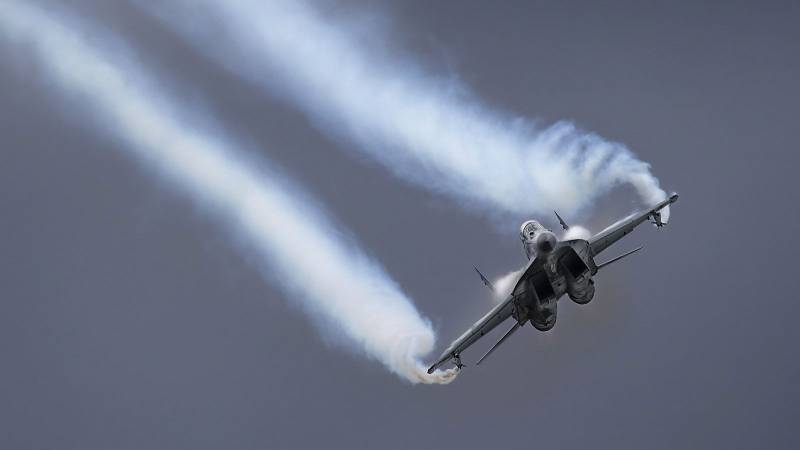
In the second half of May, 2018 year was very significant for the further formation of the tactical aircraft fleet of air and space forces of Russia event: United Aircraft Corporation (OAK) He proceeded to state acceptance testing of multifunctional super-maneuverable tactical "4 ++" generation MiG-35. factory tests, focused on the testing of the onboard radar complex, optoelectronic sensors, fire control system, and three-channel FBWCS 4x redundant, They were successfully completed as early as December, 2017 of the year.
Challenge the importance of this event is almost impossible for several reasons. "Product 9-67", operational readiness to the forthcoming attainment in 2019 year, already in the first small batches can partially compensate for the many technological drawbacks such aging machines, as the MiG-29S / SD / M2 / CMT, on the most significant air lines of the Western Military District. In particular, machine data, despite the presence in the electronic "stuffing" multiplex exchange MIL-STD-1553B bus for data integration of new elements of the "information field" cockpit, means of irradiation prevention, and future adaptation to new types of used rocket and bomb armament, equipped with the "old" pulse-Doppler airborne radar N010MP "Zhuk-ME" and N019MP "Topaz".
These products are slotted antenna arrays, with extremely low noise immunity, low bandwidth escort "en passant 'goals (10 simultaneously tracked purposes tracks), low target Duct (4 and 2 simultaneously engaged targets for "Bug-ME" and "Topaz", respectively), poor maintainability and low reliability due to the presence of common transmitting and receiving paths, as well as weak energy parameters, providing a target detection range type «F / A-18E» order 100 km (in EPR within 2 quarter. m). In more plain language, due to the presence of a single high-frequency transmitter, Radar antenna with slit lattice has low MTBF, and lower operating range observed in connection with the impossibility of such a massive installation of the transmitter, whose power would be equivalent to the total capacity of all active phased MRP.
Usually, Slit station antenna arrays are large restrictions on the minimum effective reflective surface of the sensing object (between 0.05-0.1 sq. m), because of what the long-term subtle enemy cruise missiles can not be detected even banal at a minimum distance. The only advantage of, which retains such radars in service in the second decade of the XXI century, is the possibility of implementing a software mode synthetic aperture (SAR), true, resolution radar image is obtained 15 m, therefore the small ground targets, the ability to identify the type of "launcher TRUNC" or the surface of the "gunboat" virtually non-existent, It can be performed only on visible marker classification EPR object on the multifunction display.
Here fit note, that tactical fighter families F-15E «Strike Eagle», and F-16C Block 52/52+, composed by the US Air Force, for the past few years slowly, but surely run the update program armament control complex new radar complex c AESA AN / APG-82(V)1 и AN / APG-83 SABR. Radar data is not only completely ahead of multimode, multipathing, the range of the old slot radar "Strike a needle» AN / APG-70 and "Falcon» AN / APG-89(V)9, but also partly "surpassed" by the level of noise immunity, Russian airborne radar with a passive phased array N011M "Bars" and even the "far-sighted" in the world of serial radar N035 "Irbis-E", as in Afar, With the power management software, and frequency characteristics of each receiver-transmitter module, there is the possibility sectoral "reset" radiation pattern in the direction of the director electronic jamming of enemy. It is these qualities, missing the Su-30cm and Su-35S, You should appear at the long-term "average" transition generation fighter MiG-35, basis avionics which for the first time in the history of Russian military aircraft will be radar with active phased array "Bug-A" (in FGA-35 modification), provided 960 receiving and transmitting modules with a capacity of 8 W.
This radar detects air targets with confidence with EPR 1 quarter. m in the range of about 140 km, at the same time, "tying the track" 30 of them and takes on the precise tracking of 6 facilities for interception by long-range air combat missiles with active and semi-active / passive radar homing system RVV-SD. Tactical fighter F-15E «Strike Eagle» mixed suspension configuration (EPR about 7 quarter. m) It can be detected at a distance of about 250 km. As the main advantages of "Bug-A" in the work of surface and ground targets noted in the resolution synthetic aperture mode 0,5 m, What does the information table, provided by the developer (JSC "Corporation" Fazotron-NIIR ") in addition to the full-size demonstrator. It is this ability to identify RFCs on shallow targets can be compared with on-board radar N036 "Squirrel", mounted on fighter 5th generation Su-57.
An important part of supply adopted aerospace forces Russian multirole MiG-35 is their relatively small price, about 45-50 million. dollars (1.3-1.5 times less, What the Su-35S). Consequently, the Russian Ministry of Defense expects to buy about 170 similar machines, have significantly better parameters Interference BRLK in air battles in the medium and long range compared to the "drying". The next item is more logical to consider the possibility of multifunctional MiG-35 "passive work" at surface, ground and air targets enemy, that includes full use of the integrated opto-electronic systems without the active mode radar "Zhuk-A". This technique is the use of fighter aircraft armament control complex to minimize the likelihood of opening their own locations such means ELINT enemy, as multipart prevention of irradiation station with the distributed aperture AN / ALR-94 fighter unobtrusive F-22A, consisting of 30 highly sensitive antenna modules, capable pelengovat radiation source at a distance 460 km and more, RTR complex 55000 AEELS («Automatic Electronic Emitter Location Systems») strategic reconnaissance aircraft RC-135W / V «Rivet Joint», or ship station AN / SLQ-32 electronic intelligence(V)2, martial imparted information management system «Aegis» destroyers class "Arley Burke".
If you look, for example, an early plane demonstrator MiG («№ 154»), developed on the basis of the experimental double MiG-29M2 and MiG-29KUB more in 2006 year to attract the attention of high-ranking military officials of the Indian Defense Minister (in the tender MMRCA), you can pay attention to the rich range of integrated opto-electronic means. In particular, on board of the machine seen: nasal optoelectronic system OLS-UEM (It operates in the infrared / television channels of sight and is able to detect targets at a range of 45-50 km in the rear hemisphere and 20 km in the forward hemisphere), the same dual-band optical-electronic complex OLS-K (It detects a large armored vehicles at a distance of individual units 20 km, small landing craft - 40 km and ships of class "frigate" - 90-120 km, depending on meteorological conditions), Placed in a conformal container right nacelle, and a station detecting attacking missiles (soiree).
The latter is represented by the infrared sensor of the lower hemisphere review (NA-SAR) and the upper hemisphere (VS-OAR), capable of hot flare of a rocket engine to detect and track virtually any missile (from anti-radar and anti-aircraft at a distance of up to 50 km to the air combat missiles AMRAAM family - about 30 km). Furthermore, the system is able to detect launches of short-range ballistic missiles and cruise missiles "Tomahawk" to a few hundred kilometers away, as well as complex DAS American fighter of the 5th generation F-35A. As is known, through appropriate software and hardware options can achieve full synchronization with CoAPO BCCH fighter, which ultimately will allow the operator systems (second pilot MIG-35) target designation of the sensors of the system to direct missiles "air-to-air" class not only enemy fighters, but on attacking missiles and air combat missiles of the enemy. Under these objectives adapted air combat missile R-77, RVV-SD, P-73 RDM-2, and RVV-MD.
In practice it looks as follows:. Fighter of "4" and "4+" MiG-29S, MiG-29SMT and Su-27, equipped with obsolete radar system with slotted antenna array N019MP "Topaz", "Zhuk-ME", as well as the Cassegrain antenna N001, They have little or no opportunity to intercept the enemy launched air combat missiles due to lack of capacity in advance to detect such small targets and capture them on autofollow (an effective reflecting surface AIM-9X Block II and AIM-120D hardly reaches 0.03-0.07 sq. m). Successful implementation of such interception can occur only in the case, if the pilot to visually detect the vanishing point "Sidewinder" with underwing pylons enemy fighter, located at a distance of 8-10 km, and instantly apply the "standby" plume capture incoming missile through GOS own F-73. As is known, this "fast" mode requires only a combination of sighting crosshairs, is a cone scanning missiles IKGSN, with a visible object teplokontrastnym.
But such a "trump" the possibility is unlikely to be a frequent event in air battles of the XXI century, wherein AIM-120C / D c run distance of 50-100 km. Furthermore, visually detect the start of a rocket solid propellant with a modern low smoke fuel is not so easy. Consequently, only infrared detection station attacking missiles, synchronized with IMC fighter, able to make a reality of these plans to destroy the enemy URCEX. In the US, such a concept is the use of air combat missiles slowly moving towards the implementation of the ambitious project within the SACM-T («Small, Advanced Capability Missile Technologies»), the development of which has for several years engaged in military-industrial company, specializing in the design missile and radio-electronic means «Raytheon» and Research Laboratory US Air Force («Air Force Research Laboratory»).
At the heart of this project, launched the company "Lockheed Martin", It is smaller than the other creating a radically improved ("Truncated") modification of class "air-to-air" missiles AIM-120C AMRAAM. Product, also called CUDA, to be equipped with high-active radar homing millimeter wave, and 13 "Gasdynamic belts" of more than hundreds of miniature motors lateral control, ensuring kinetic intercept missiles destroy enemy by direct contact. Start receipt «SACM-T / CUDA» In ammunition Air Force fighter and the US Navy is expected to top the 30-ies, and therefore the specialists GosMKB "Vympel" there is plenty of time for giving air combat missiles RVV-SD qualities missiles for self-defense. Another question is how, that a similar priority to the modernization of defense funds for fleet not VKS say today, no military-diplomatic sources, nor the developer; but there is still such a moment as financing, which altogether better to keep quiet.
picture emerges, similar to the slip of the program "once-through" long-distance air combat missiles RVV-AE-PD. And it was from the promotion of such projects will depend on the safety of our flight personnel of air and space forces in the event of a collision with an aircraft Western Force. Thus it can be stated, that issues self Russian VKS all hope can only fighter missile to link R-77 family with the station detecting attacking missiles (soiree), but consider this linkage as an ideal asymmetric response to the US project SACM-T did not have to, because the aircraft performance characteristics of the CUDA-interceptor missiles will almost 2 times the RVV-AE due to gas-dynamic control, because the first was originally designed to fight small-sized enemy missiles "B-B".
We move on to evaluating design changes placing opto-electronic module to work in the "air-surface" on new prototypes of MiG-35 Russian VKS, as well as related changes in positive and negative effects. If you look closely at an early demonstrator MiG-35 with tail "154" number, gathered for demonstrations within MMRCA, and then the last demonstrator «# 702 blue», passed factory flight tests in 2017 year, you can pay attention, that the first set of optical-electronic complex OLS-K in a small-size module streamlined conformal container, on the lower surface of which is placed optikoprozrachnaya turret for the lower hemisphere review.
The mass of this module, as well as low drag coefficient, that only marginally affects the combat radius of action. On demonstrator with onboard "702" number for Russian videoconferencing, we can draw attention to the more massive and bulky hanging container opto-electronic complex T220 / E. As it appears, it is this complex will be used on the Russian MiG-35. undoubtedly, its main disadvantage is the considerable aerodynamic drag due to the diameter of the container 370 mm and a very large knot fastening to the right nacelle, which will reduce the range of a few tens of kilometers. You should also expect an additional reduction of the maximum speed (in the presence of missiles in sling) from 2100 to 1850-1900 km / h.
Have complex T220 / E and serious advantages over OLS-K. This is a much better view of the upper sector of the elevation plane, achieved thanks oriented in the forward hemisphere rotary turret of the container, Unlike stationary turret OLS-K, "Looking down". Due to this, T220 / E can not only conduct a review of the lower hemisphere, but "look" at an angle of 7-10 degrees above the horizon (the upper hemisphere). Consequently, complex can be applied for classification and identification of remote air targets in the television band, in addition to OLS-UEM.
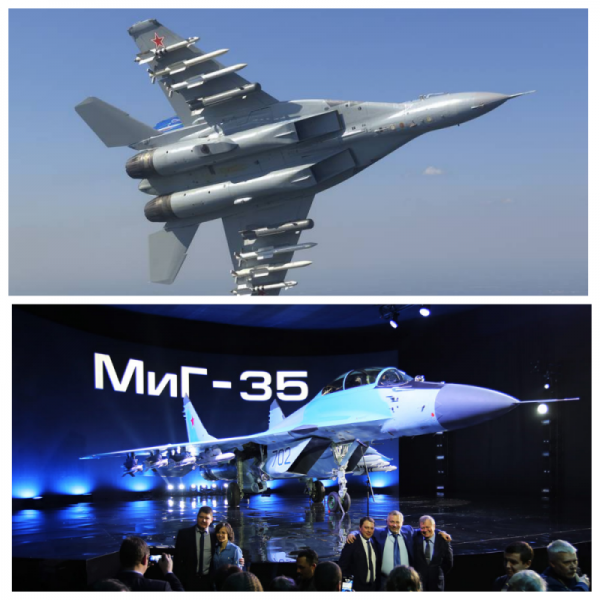
top photo: demonstrator MIG-35 (board №154) with opto-electronic sighting complex OLS-K; lower: prototype of the MiG-35 (board №702) for factory and state tests with the suspended container T220 / E
Besides, judging from the much larger "turret head" T220 compared to the OLS-K, the former has a much more long-focus and high-aperture optical system, allows to realize optical magnification of the observed object in the 30X and more, not counting digital.
Not without T220 / E and disadvantages. One of them is the impossibility of constructive self-centering of the lens at angles more 20 degrees from the longitudinal axis of the suspended container. result: It excludes the possibility of a review of the lower sector of the back hemisphere (operator systems of the MiG-35 will not be able to keep track of ground tactical situation "in the tail" of the machine without having to turn the fighter). Complex OLS-K can boast this feature. What tactical advantages does this feature OLS-K? It eliminates the need for resetting the fighter in the direction, saturated with modern air defense systems of enemy small range, which cover scouting object.
In addition to the standard opto-electronic reconnaissance of ground targets in the rear hemisphere, OLS-K provides more illumination and for tactical missiles with semi-active laser homing, running with other carriers (from Su-25 and anti-complexes "Hermes" in various versions). Such opportunities to work with goals in the rear hemisphere does not give any domestic or foreign container sighting and navigation system, including such well-known products, as "Sapsan-E", and shtatovskih «Sniper-ATP» («Advanced Targeting Pod»). only products, which by CPN field of view closer to the OLS-K, French is suspended complex «TALIOS Multi-Function Targeting Pod» and the Turkish «ASELPOD-ATP», "Turret head" which rotate on bearings in a vertical plane. Whatever it was, will have to be content with the technological advantages of the complex T220 / E, Considering, that none multirole fighter generation "4+" MiG-29 SMT, Su-27SM and Su-30 until today have not been implemented suspended reconnaissance and target designation.
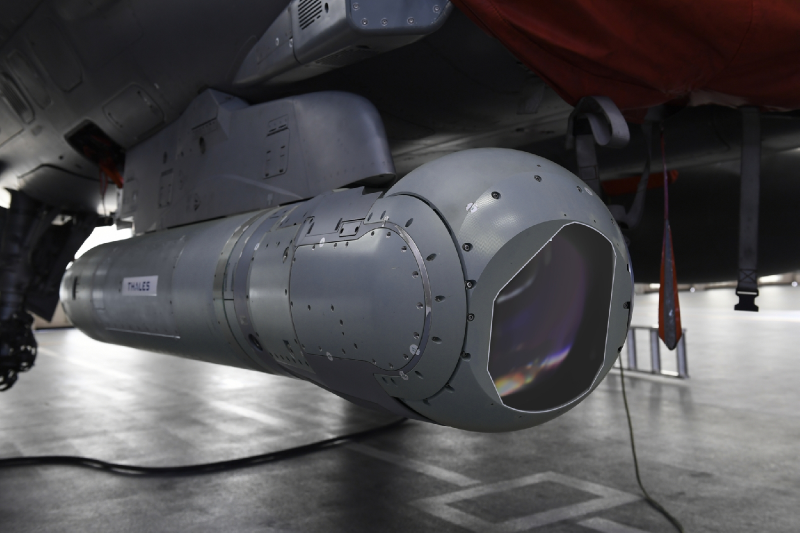
Container opto-electronic complex TALIOS
Against the background of all the above advantages of armament control complex multifunctional MiG-35, absolutely unfounded looking statements various Russian experts in the article "Experts have rejected the ship's MiG-35" on the resource "Ytro.ru". So, in the publication of the opinion can be found the chief editor of the magazine "Arms Export" Andrey Frolov, according to which the MiG-35 is obsolete as a platform for the development of perspective aviation complex deck. In fact, argues active output "voracious" turbofan engines RD-33MK / MAC, short-range combat, as well as the radar signature mismatch glider indicators 5th generation machines. But it still is sad folds for advanced modification of the fighter MiG-29, Glider is still on for decades will be deemed "aerodynamically standard" on a par with gliders family of T-10?
New "products 9-61 / 67" through the introduction of more elements, represented by composite materials, remain empty ("Dry") weight in the range 11000-11500 kg, while the normal takeoff weight with 4800 kg fuel, and 6 RVV-SD and 2 RVV-MD on hangers around 17,8-18 tons. When part of fuel consumed, (at the time of the air battle) weight of the car will be in the range 16 tonnes, that the total thrust turbofans RD-in 33MKV 18000 kgf provides the thrust-to-weight ratio in 1,12 kg / kg. It is good for close air combat with the "Super Hornet", even using ordinary steady rotation with angular speed 23 city / a. And there is also a system of all-aspect thrust vector deflection!
If we talk about the effective reflective surface (EPR) MIG-35, then we have a reduction to 1.2-1.5 using q radar absorbing coatings. m, that for the transitional generation fighter is simply an excellent indicator. MiG-35 and I did not think specialists RAC "MiG" as the concept of the 5th generation, Nevertheless, the level of avionics is consistent with this level. A striking example is the work of the "Boeing" of such machines generation "4 ++", как F-15SE «Silent Eagle» (airframe design more 45 years, but no one in the United States does not name this fighter "old scrap") или F-16 Block 70. As for the range in 1000 km, then the multi-purpose (moreover deck) medium fighter is gangbusters; just look F / A-18E / F or F-35A. Another thing, that under a huge issue, and in the fog of uncertainty is the construction of an aircraft carrier head-class "Storm", not to mention the series ... But this issue has already been a very different review.
Information sources:
https://utro.ru/army/2018/05/31/1362632.shtml
http://bastion-karpenko.ru/guk-a/
https://combataircraft.keypublishing.com/2017/03/24/usaf-still-evaluating-f-16-radar-upgrade/
http://airwar.ru/enc/fighter/mig29smt.html
http://airwar.ru/enc/fighter/mig29m2.html







